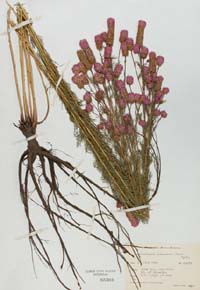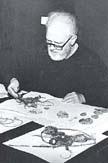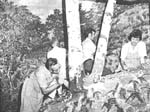What is a herbarium?
A herbarium is a
collection of carefully preserved, pressed plants stored in special
cabinets in a climate-controlled room. Herbarium is also the name for
the building or facility in which the collection is stored. Many natural
history museums, universities, and natural history surveys have herbaria.
 What
kinds of plants are represented in a herbarium?
What
kinds of plants are represented in a herbarium?
Herbaria contain a wide range of plants from many different families.
In larger herbaria, plants ranging from fungi, lichens, mosses (bryophytes)
and ferns, to grasses, forbs, and trees are represented. Plant specimens
are dried and mounted on large sheets of herbarium-quality paper and
placed in folders, which are organized alphabetically by family, genus,
and species. Monocots (the lily family and the grasses, for example)
and dicots (most flowers and vegetables) are sometimes the two major
divisions or sections within the herbarium.
Where do the
plants in the herbarium come from?
Herbarium collections have a variety of origins. Researchers at academic
institutions and museums collect, identify, and preserve plant specimens
from natural areas for their herbaria. Botanists and ecologists, both
amateur and professional, also make personal collections, which, in
time, they may donate to larger herbaria affiliated with museums, universities,
and botanical gardens. When private collections are donated, they are
frequently catalogued and integrated into the larger collections of
these institutions.
Many of the earliest
and most interesting components of larger herbaria were donated by so-called
amateurs, who, in reality, were astute botanists, often with a keen
interest in several areas of natural history. For many of these individuals,
botany was a second profession. A number of early "second career"
botanists were physicians.
 How
are plant specimens preserved?
How
are plant specimens preserved?
There are
two aspects of preservation. The first is the preservation of the physical
specimen.
After plants have been collected in the field, they must be dried as
soon as possible to prevent mold growth. Typically they are placed in
a plant press and then moved to a drying cabinet.
Dried specimens
are mounted on special, acid-free herbarium sheets. Good specimens include
representative parts, such as flowers, leaves, roots, fruits, and seeds.
Fruits and seeds that cannot be pressed flat onto a herbarium sheet
are often stored in a paper pouch attached to a corner of the herbarium
sheet. Likewise, mosses, lichens, and fungi are sometimes stored in
labeled envelopes and are catalogued according to family, genus, and
species.
The second aspect
of preservation is maintenance of the information related to the collection
of each specimen. The thorough examination and inspection of the specimen
is critical. Herbaria have libraries of reference books, botanical keys,
and publications on plant distribution to aid in this inspection and
identification.
 The
plant is described by its scientific name, which may be changed over
time. Other information on the herbarium sheet should include the date
the specimen was collected, the location from which the specimen was
collected, the name of the collector, the collector's description number,
and a description of the habitat. This information is usually written
or printed in the lower right-hand corner of the herbarium sheet. (On
herbarium sheets of the Illinois State Museum, a museum accession number
is also printed or stamped.)
The
plant is described by its scientific name, which may be changed over
time. Other information on the herbarium sheet should include the date
the specimen was collected, the location from which the specimen was
collected, the name of the collector, the collector's description number,
and a description of the habitat. This information is usually written
or printed in the lower right-hand corner of the herbarium sheet. (On
herbarium sheets of the Illinois State Museum, a museum accession number
is also printed or stamped.)
These data provide historical
background about collectors, plant populations and distribution at points
in time, and sometimes a glimpse at the (Illinois) landscape prior to Euro-American
settlement. When looking at collections as a whole, the data provide a picture
of the diversity of plants in an area, and inform us of the presence and distribution
of rare native plants species and of invasive, introduced plants in a region.
This is useful to ecologists, taxonomists, farmers, and conservation scientists.
Who uses the
herbarium?
 Scientists
who study taxonomy, ecology, and evolutionary plant biology use herbaria.
People with an interest in the distribution and diversity of plant specimens,
for example, historians and landscape archaeologists, also use herbaria.
Scientists
who study taxonomy, ecology, and evolutionary plant biology use herbaria.
People with an interest in the distribution and diversity of plant specimens,
for example, historians and landscape archaeologists, also use herbaria.
Museum exhibit
designers use the herbarium as a research tool when creating exhibit
flora or landscape murals for exhibit backgrounds.
The herbarium provides
plant identification services. The collections of herbaria are educational
resources for the community and academia. Sometimes
individuals simply want to know the name of an unusual plant that grows
on or near their property.
Related Activities:
Leaf Collection (html) (pdf)
Other Herbaria
to use as a resource:
Morton
Arboretum
https://www.mortonarb.org/
llinois
Natural History Survey's Bontany collections
https://www.inhs.uiuc.edu/cbd/collections/plants.html
Stover_Ebinger
Herbarium, Eastern Illinois University
https://www.ux1.eiu.edu/~cfgct/eiu-herbarium.htm
Northern
Illinois University Herbarium, DeKalb
https://www.bios.niu.edu/herbarium/
Southern
Illinois University Herbarium, Carbondale
https://www.science.siu.edu/plant-biology/herbarium/index.html
Western
Illinois University Herbarium, Macomb, with links to others
https://www.wiu.edu/users/mibiol/facility/herb/herb.htm

